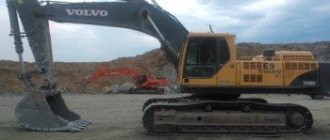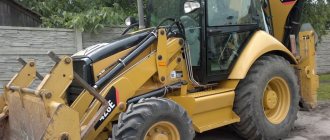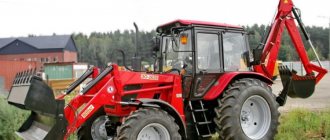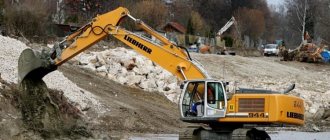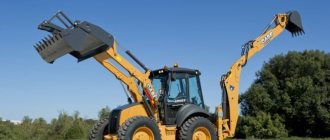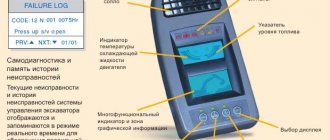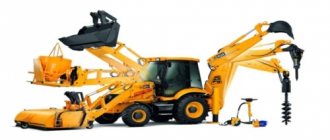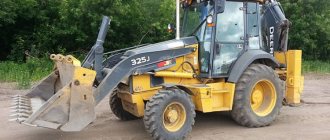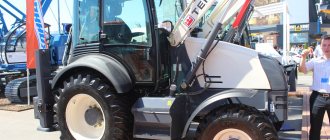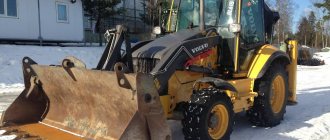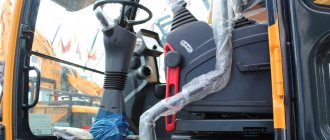There are rarities from the past that we can be proud of. Moreover, we can still use them today if they are well preserved. These include the universal excavator EO 4321. It began to be produced back in 1972 in Kiev. In a short time, he gained popularity and respect from machine operators and builders. It was the first mobile crane in the USSR on hydraulic wheels with a 360% rotation, with a hydraulic boom. This excavator was in great demand. Therefore, it was produced in large numbers in the 70s and 80s. 35% of the excavators produced at that time were produced on. He began to work successfully in all the republics of the country.
Advantages and disadvantages
The versatility of the machine was that the necessary equipment for work could be attached to the hydraulic attachment system, and then removed. The backhoe can be changed. There are several of them, of different capacities. In addition, this main working tool could be disconnected and replaced with a grab, jaw-grippers, a slotting hammer, and a ripper tooth. The machine operates in 40% frost (with non-icy soils) and 40% heat. It should be noted that the excavator is economical and efficient. Despite its many advantages, this machine had disadvantages . During long-term maintenance, hydraulic hoses begin to leak. If worked with too much force, the swing frame could burst.
Excavator EO 4321 at work
The model of the fourth group of specialized equipment worked (and continues to work) in agriculture, transport, and construction. In the army, the machine was previously used in technical troops. But the technical characteristics of the EO 4321 were inferior to Western machines of this type. Therefore, in 1983 the car was modernized and the “A” model began to be produced. The engine was left the same, but the volume of the backhoe was increased. Improved hydraulics. 3 years after the start of production, in 1986, model “A” was discontinued. The production of EO 4321B, an even more improved machine, began. It was very different in its characteristics from the previous two models. The engine was replaced, the shovels were improved, the rotating frame was made stronger so that it would not break under overload.
Be sure to read: Excavator EO 4121: technical specifications
But, since even the improved machine was inferior to similar Western technology, EO-4322 began to be produced in 1989. After the collapse of the Union, the Kiev company was renamed JSC Atek. Model EO-4322 has been modernized. Atek 4321 began to be produced, according to the nomenclature classification of the renamed plant, and so it is considered as model 4321B, because it absolutely repeats all the characteristics of the car of the 80s. The only difference from the previous model is that they made a different diesel engine, and the hydraulic motor is installed at the top of the platform, and not at the bottom. This excavator was produced throughout the 90s. It can be recognized by the characteristic yellow and red color of the coating. Now the release of this car is in doubt. The bankrupt plant has not been operating for several years. And the famous excavators of the 70s and 80s can be bought used. They are still working successfully throughout the territory of the former Union, including in Russia. Now the Russian EK-18 is an analogue of this machine.
Features of the EO 4321 excavator
This model was first manufactured back in 1972 at the Kiev Machine-Building Plant. EO 4321 had all the necessary parameters and mechanisms for carrying out work in the field of agriculture, construction of buildings and transport facilities. This model belongs to the fourth group of specialized equipment.
A distinctive feature of the EO 4321 wheeled excavator model is that this excavator was the first pneumatic wheeled machine with a hydraulic boom. It was he who became the founder of subsequent modifications. The unique combination of efficiency and cost-effectiveness in use contributed to the spread of EO 4321 throughout the union.
This excavator was in service with the engineering troops and worked on almost all construction sites.
The positive qualities of the model include:
- Large bucket capacity;
- Availability of own supporting parts with hydraulic drive;
- Increased productivity by replacing a mechanical drive with a hydraulic one;
- Using an excavator blade to improve stability;
- Easy access to all elements of the engine and attachments reduces the cost of maintenance personnel and reduces repair time.
Photo of excavator EO 4321
Also, the advantages of the EO 4321 excavator include its versatility. Depending on the work performed, it is possible to attach various equipment to the hydraulic boom. Possibilities include excavation and trenching, well digging, site leveling, and hard rock loosening and crushing.
General technical specifications
The machine with the main bucket weighs 18.8 tons and has the following parameters:
- bucket volume – 30.5/0.8 m;
- bucket lift – up to 5.6 m;
- digs to a depth of 5.5 m;
- unloading soil at a distance of 7 meters 16 cm;
- size – 9.9x2.84x3.99 m;
- moves at a speed of 20 km/h;
- machine length – 9 meters 90 cm;
- from the left side of the platform to the right - 2 meters 84 cm;
- force for digging soil - 150 kN;
- turning radius circle – 7 meters 30 cm;
- Fuel tank capacity – 320 l.
- in a minute the platform can rotate 11.5 times.
The machine has wide-profile wheels, replaceable buckets, and shovels. Replaceable equipment : hook suspension, drills, hammer, grabs, ripper tooth.
Diesel characteristics
The excavator has a 4-stroke, 4-cylinder SMD-17M engine, it has the following parameters;
- volume – 6.3 l.;
- speed – 1950 rpm;
- power - 58.8 (80) kW (hp);
- cylinder diameter – 120 mm;
- the motor weighs – 680 – 735 kg;
- diesel fuel consumption is 210 g/kW (155 g/l s per hour).
Be sure to read: Do-it-yourself trailed mini-excavator
The engine is cooled and fuel injected.
EO 4321
Video
The model was used to work with non-icing soils belonging to categories 1-4 (unloading, moving, dispersal and development). The excavator worked well with icy soils of category 5 and higher and rocky rocks. However, they first needed to be crushed into pieces 40 cm long. EO-4321 felt great at temperature conditions from -40 to +40 degrees.
The excavator belonged to the 4th size group of machines and was widely used in transport, industrial, urban and rural construction, as well as in loading and unloading and earthworks.
In 1983, the basic version of EO-4321 underwent a major modernization. began producing a modification of the EO-4321A with an old engine and an increased volume of the backhoe. The modernized version has a more reliable hydraulic system. Production of EO-4321A lasted three years. In 1986, the excavator received an improved engine. The model was soon discontinued. It was replaced by the EO-4321B version, the technical parameters of which were changed almost beyond recognition. However, even the updated version was noticeably inferior to the best foreign analogues. As a result, in 1989, production of EO-4321B ceased. "Red Excavator" has begun production of the EO-4322 modification.
Excavator device
There is an operator cabin in which everything for control is located. The chassis is equipped with a frame with a turning circle. There are outriggers. Before work, they are strengthened and pumped up through hydraulics. For machine stability during operation. The transmission is not manual. Transmission is carried out through planetary gearboxes. The driving axle is the front one. It's on hinges. Steered wheels are front. Wide-profile tires: 1300 mm. The hydraulics are located on the platform and consist of a pump, valve equipment, a tank and mechanisms that drive the hydraulics. Moreover, the hydraulic system has its own distributor.
The hydraulic cylinder has a piston that helps apply force to the ground during operation. The boom has its own hydraulic system. The bucket does the same. There is a bulldozer blade with its own hydraulic system. The bucket hydraulic cylinder has an unloading valve. The platform, together with the boom and the operator's cabin, can rotate on the turntable in any direction, depending on what the operator needs. In small faces it is good to work with a straight shovel. It is better to load large fragments with a ladle-shaped ladle. For example, large rubble stones.
Working equipment
The main working part of an excavator is a backhoe, the capacity of which is 0.65 m3. If necessary, you can change the equipment to a straight shovel to develop soil above the level of the machine. For the construction of deep pits and wells, it is possible to install a grab handle on the handle. For loading bulk materials, a backhoe or straight shovel bucket is used, and for piece cargo, a special crane installation is used.
The rotating platform is located on a pneumatic wheel chassis.
This is where the power equipment, driver's cabin, tanks for working fluid and fuel, counterweight, hydraulic mechanism and its control system are located. Design of the EO 4321 excavator
The running structure consists of a durable frame and pneumatic wheels. The frame is equipped with special supports and bulldozer-type equipment. Control is carried out by turning the front axle.
Price range
for the EO 3322 excavator is relatively low : from 100 (basic equipment) to 250 (with full equipment) thousand rubles.
Excavators from later years of production will cost more than older units. The cost of a used car, as a rule, does not exceed 150 thousand rubles.
Prices for EO 3323 are approximately in the same range; on average, the cost of such an excavator is 200 thousand rubles.
Excavators of the next generations will cost more: for example, the average price of EO 4124 is already 400 thousand rubles.
The EO 6123 excavator among all those described will be the most expensive: its cost can reach up to 1 million rubles. and even exceed this figure.
Cabin description
The EO-3322 excavator has an all-metal cabin. The glass area has been increased and covers the area below the level of the driver's seat. The glass in front folds down and locks in the desired position.
Cabin of excavator EO 3322
The sprung seat is adjustable in depth and height. It is also possible to change the backrest angle.
The door is locked. In the open position it is fixed on the outer wall of the cabin. The floor surface is covered with a vibration-isolating mat made of wear-resistant rubber.
Comfortable working conditions are ensured by the ventilation and heating system. The air inside the cabin is heated due to the circulation of hot water entering after the engine has cooled. The water then returns to the heater heat exchanger. The shut-off valve allows you to shut off the flow of water in warm weather. For external ventilation, simply open the heater damper. When no coolant is supplied, it can be used as a fan.
This is interesting: Excavator EO-3323 - technical characteristics and design
Areas of application
Excavators of the EO series are united by the ability to work on difficult soils (rocky, clayey, loose, etc.). Moreover, each model has its own specifics.
EO 3322, 3322A and 3323 are the most multifunctional models and are used in a variety of jobs, such as:
- drilling of the wells;
- digging wells;
- digging trenches;
- land reclamation;
- loading of bulk substances and soil;
- soil development.
These models are equally successfully used both in construction and in agricultural work .
The EO 4124 excavator is mainly used in road work: loosening soil, breaking up frozen soil crust and old road surfaces, crushing stones (using a hydraulic hammer), laying concrete slabs.
The EO 6123 model is designed for work on rocky and frozen soil at low temperatures, therefore its kit includes special equipment - buckets with increased force on the teeth. This helps to cut through hard ground more efficiently.
Other models and modifications
Other popular models include EO 4124 and EO 6123.
The technical characteristics of the EO 6123 excavator are as follows:
- height – 4460 mm;
- maximum speed -1.55 km/h;
- weight – 67 t;
- engine power – 170 hp
The presence of a crawler track distinguishes the EO 4124 excavator. Its technical characteristics are as follows:
- height – 4000 mm;
- maximum speed – 3.5 km/h;
- weight – 32 t;
- engine power – 180 hp
The model has the following modifications:
- EO 4124A;
- EO 41245A-07;
- EO 4124HL, designed for operation at low temperatures.
